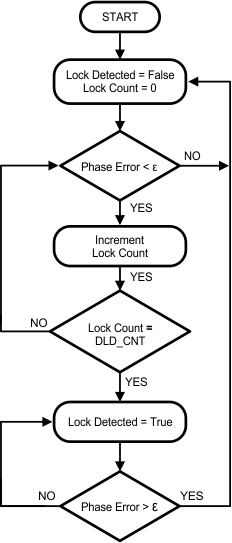ZHCSHU9K September 2011 – December 2023 LMK03806
PRODUCTION DATA
- 1
- 1 特性
- 2 应用
- 3 描述
- 4 Pin Configuration and Functions
- 5 Specifications
- 6 Parameter Measurement Information
-
7 Detailed Description
- 7.1 Overview
- 7.2 Functional Block Diagrams
- 7.3 Features Description
- 7.4 Device Functional Modes
- 7.5 Programming
-
8 Application and Implementation
- 8.1 Application Information
- 8.2 Typical Application
- 8.3 System Examples
- 8.4 Best Design Practices
- 8.5 Power Supply Recommendations
- 8.6 Layout
- 9 Device and Documentation Support
-
10Register Maps
- 10.1 Default Device Register Settings After Power On Reset
- 10.2 Register R0 TO R5
- 10.3 Registers R6 TO R8
- 10.4 REGISTER R9
- 10.5 REGISTER R10
- 10.6 REGISTER R11
- 10.7 REGISTER R12
- 10.8 REGISTER R13
- 10.9 REGISTER 14
- 10.10 REGISTER 16
- 10.11 REGISTER 24
- 10.12 REGISTER 26
- 10.13 REGISTER 28
- 10.14 REGISTER 29
- 10.15 REGISTER 30
- 10.16 REGISTER 31
- 11Revision History
- 12Mechanical, Packaging, and Orderable Information
8.1.6 Digital Lock Detect
The digital lock detect circuit is used to determine the lock status of the PLL. The flowchart in Figure 8-6 shows the general way this circuit works.
| EVENT | PLL | WINDOW SIZE (ε) | LOCK COUNT |
|---|---|---|---|
| PLL Locked | PLL | 3.7 ns | PLL_DLD_CNT |
For a digital lock detect event to occur there must be a number of PLL phase detector cycles during which the time/phase error of the PLL_R reference and PLL_N feedback signal edges are within the 3.7 ns window size of the LMK03806. Lock count is the term which is used to specify how many PLL phase detector cycles have been within the window size of 3.7 ns at any given time. Since there must be a specified number phase detector events before a lock event occurs, a minimum digital lock event time can be calculated as lock count / Fpd.
 Figure 8-6 Digital Lock Detect Flow Diagram
Figure 8-6 Digital Lock Detect Flow DiagramA user specified ppm accuracy for lock detect is programmable using a lock count register. By using Equation 8, values for a lock count and window size can be chosen to set the frequency accuracy required by the system in ppm before the digital lock detect event occurs. Units of Fpd are Hertz:

The effect of the lock count value is that it shortens the effective lock window size by dividing the window size by lock count.
If at any time the PLL_R reference and PLL_N feedback signals are outside the time window set by window size, then the lock count value is reset to 0.
For example, we will calculate the minimum PLL digital lock time given a PLL Fpd of 40 MHz and PLL_DLD_CNT = 10,000. The minimum lock time of PLL will be 10,000 / 40 MHz = 250 µs.